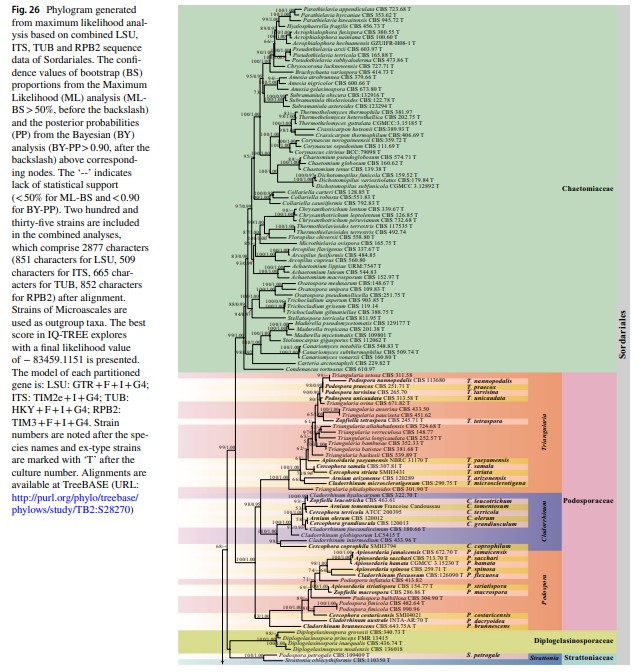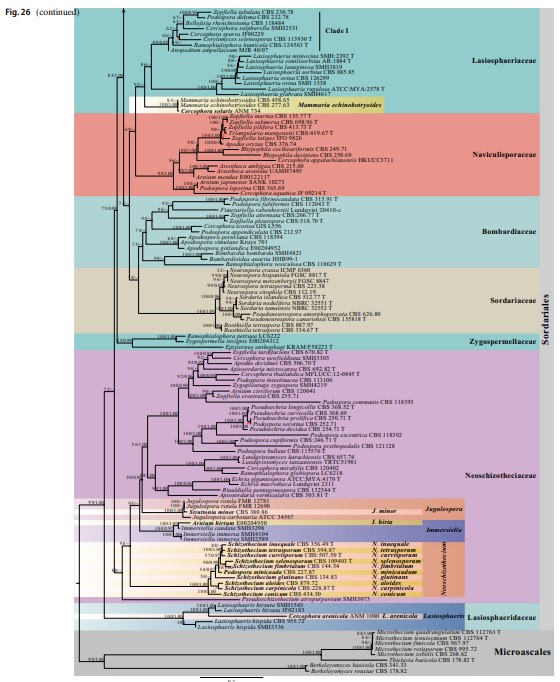Lasiosphaeridaceae S.K. Huang, Maharachch. & K.D. Hyde, Fungal Diversity: 10.1007/s13225-021-00488-4, [67] (2021)
Index Fungorum number: IF 558345; MycoBank number: MB 558345; Facesoffungi number: FoF 10142
Etymology – Named for Lasiosphaeris, the type genus of this family.
Saprobic on wood. Sexual morph: Ascomata perithecial, solitary, superficial to semi-immersed, subglobose to obpyriform, black, ostiolate, tuberculate or/and surrounded by brown, septate setae or hairs. Asci 8-spored, unitunicate, cylindrical, with J- apical ring and a subapical globule. Ascospores cylindrical to geniculate or sigmoid, aseptate to multi-septate, ends rounded, hyaline to pale brown, becoming brown to dark brown, ellipsoidal to broadly fusiform at apical cell(s), sometimes with a terminal, short, conical gelatinous appendage at each end. Asexual morph: Hyphomy- cetous, phialophora-like. Conidia oval to globose, hyaline (adapted from Tode 1791; Hilber and Hilber 1979; Miller and Huhndorf 2004a).
Type genus – Lasiosphaeris Clem. 1909
Notes – Lasiosphaeris is similar to Lasiosphaeria and Immersiella in having geniculate or sigmoid ascospores, but Lasiosphaeria has white furfuraceous tissue covering on the surface of the ascomata, and Immersiella has immersed ascomata, whereas Lasiosphaeris has superficial, hairy ascomata (Tode 1791; Clements 1909; Miller and Huhndorf 2004a; Kruys et al. 2014). However, these three genera were subsequently found to be far apart in phylogenetic analysis (Miller and Huhndorf 2004a; Kruys et al. 2014; Marin-Felix et al. 2020; this study). Miller and Huhndorf (2004a) regarded Lasiosphaeris species as an independent clade in Lasiosphaeriaceae based on LSU sequence data. Marin-Felix et al. (2020) showed that Lasiosphaeris is sister to Zygospermella based on multi-gene analysis. In this study, Cercophora arenicola, Lasiosphaeris hirsuta and L. hispida form a clade (100%ML/1.00PP) which is nested in Sordariales as an orphan clade (72%ML, Fig. 26). Furthermore, Cercophora arenicola is similar to Lasiosphaeris which has hairy ascomata, cylindrical to clavate asci with a subapical globule. Still, ascospores have swollen apical cells with a terminal appendage at each end (Hilber and Hilber 1979). Therefore, we accepted C. arenicola as Lasiosphaeris arenicola (see the combination list below) and delimited the new family Lasiosphaeridaceae based on Lasiosphaeris.


Species
